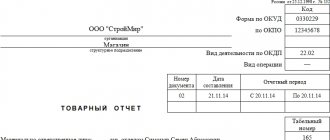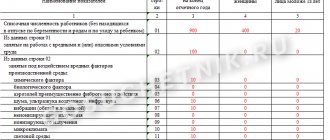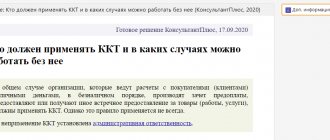Product label of form TORG-11 is a specific form of description of goods in the warehouse. It is ideal for inventorying clothes and shoes. Facilitates the work of the storekeeper when taking inventory. The product label serves as the basis for filling out an inventory list of inventory items.
- Form and sample
- Free download
- Online viewing
- Expert tested
FILES
The inventory process should not be very long (limited to a day). If the inspection lasts a long time, then it is more advisable to draw up not a product label, but a special one - an inventory one.
The product label consists of an album of unified forms of primary accounting documentation. There is a footnote about this in the document form.
Who fills out the TORG-11 form
The product label is filled in at the moment the goods or material assets arrive at the warehouse. Registration is carried out by the person financially responsible for inventory items in the warehouse. Next, the contents of the TORG-11 form are checked by a higher-ranking warehouse employee - manager, senior storekeeper or warehouse worker of another position.
If the indicators of the product label correspond to the actual parameters of the product, the person in question puts a signature, after which the document remains in the place where the valuables are stored. A product label is filled out for each item of product arriving at the warehouse for storage.
How to fill out a document
The product label of the TORG-11 form is filled out as follows:
- First you need to indicate the name of the organization and its address. If accounting is kept by structural unit, indicate its name.
- On the right side of the document you need to write down the code according to OKPO, the type of activity according to OKPD, the type of operation, and the date of the inventory.
- Next, indicate the date the product label was drawn up and the number assigned to it.
- After this, they proceed to filling out the tabular part. Here they indicate: the name and code of the product, article number, unit of measurement, quantity, accounting price (sale or purchase price of the product), etc. They also indicate the characteristics of the product - model, color, size, etc. At the bottom of the table, you must enter the total quantity of inventory items.
- Below the table, write the quantity of goods in words.
- The document is signed by the warehouse manager and the responsible official.
Each label must bear the signature of an employee who verified the quantitative and qualitative characteristics of the product. It is also necessary to verify the information from the labels with the data entered in the inventory list.
If an error was made when filling out, you can cross out the incorrect information and write down the correct information next to it. The responsible person must put his signature next to the correction. The basis for drawing up inventory documents can only be a correctly executed form TORG-11.
Who signs the TORG-11 product label
The label is signed by the persons who filled out the document and checked the correctness of filling out the document, this could be:
- A manager of a warehouse or other place where goods and materials are located (warehouse manager, store manager);
- A warehouse employee, for example, a storekeeper, financially responsible for a given product;
- Accounting representative.
The signature is placed after checking that the materially responsible person has filled out the TORG-11 form for the goods received at the storage location.
The signed product label is not submitted to the accounting department; the document is needed solely for warehouse accounting of inventory items at storage locations, so the verified and signed document remains in the warehouse.
Definition of concepts
Document flow is the main component of the organization of accounting, management, warehouse and other types of accounting. It was created to conduct continuous monitoring of the business activities of the company. Without it, not a single enterprise can operate, everyone will be confused, and it will become extremely difficult to pay taxes. The primary warehouse accounting document is each document that was the basis for any operation. It is compiled either during the event or after by representatives of all interested parties. It is also the legal basis for creating an account.
Each of them is drawn up only in accordance with its standard form approved by law. They are a prerequisite for the uninterrupted operation of all newly opened companies in our state. Moreover, it is not necessary to compile everything in paper form; electronic form is often sufficient.
Errors in filling out the product label
The financially responsible person filling out the TORG-11 form must not make mistakes in indicating information about inventory items. It is necessary to provide the most complete information about all items stored on a specific shelf (cell). It is necessary to indicate not only the name, but also detailed individual characteristics of the property (article number, grade, size, etc.).
There should be no errors in indicating quantity and price. The price is determined in accordance with the accompanying documentation, as well as the organization’s procedure for accepting inventory items for accounting. Valuables can be accepted into the warehouse at the purchase price specified by the supplier, or at the selling price, including a trade margin.
Errors in the design of the label will not allow you to correctly fill out the inventory list in the future; therefore, you should carefully fill out the tabular part of the TORG-11 form. The determining factor when filling out the TORG-11 form is the location of the product, so the product label remains in a specific cell (compartment, shelf), therefore, it is allowed to include all the names that are in a given cell in one form.
Since the product label is used when filling out the INV-3 inventory list, the signature of the person who verified the completion of the TORG-11 form is required. By putting his signature, the manager of a warehouse or other storage location confirms that all information is correct, and the volume of inventory items that is reflected in the product label is actually stored in this location.
The label must be signed not only by the employee who checked the correctness of registration, but also by the materially responsible employee who filled out the document. Only if the specified signatures are available, the product label data can be used to fill out inventories when taking inventory of goods and materials.
In what situations is it applicable?
It is convenient to use this document in situations where:
- the organization is engaged in the production or resale of clothing, shoes, and various accessories of various sizes;
- lengthy inventory is not expected;
- Each product item has an article number;
Important point! The warehouse accounting unit will not be the product, but the cell in which it is stored. Even if there are several types of goods in the same cell during inventory, there is only one label for them.
If it is more convenient for the storekeeper to create a label for each type of product in the cell, then such filling is also acceptable.
Invoices in warehouse accounting
Despite the variety of accounting and primary accounting forms, the warehouse invoice is the main document. The form is used to reflect the receipt of assets at the warehouse and to register the disposal of inventory items during sale or to third parties.
The preparation of invoices is carried out by the party that transfers the goods: the seller or supplier. For example, when purchasing a product, a company receives a ready-made TORG-12 form. Based on this document, the shipment of goods is recorded in the organization's warehouse records.
Already when selling an asset, for example, when selling its own products, the company independently fills out TORG-12, since the company itself acts as a seller. All necessary information about the parties to the transaction is filled in (buyer, seller and transport company, if necessary). Then detailed information about inventory items is recorded.
Product storage information
The value and importance of this part of the document flow is reflected in:
- Material accounting cards. Here a separate sheet is created and recorded by size, shape, license plate. Then it is transferred to storekeepers along with the assortment itself.
- Collation statement. Store for several years. It contains information about when the last inventories were carried out and how they ended. Using them, you can identify the features of high-quality storage of raw materials and finished products.
Warehouse card
It is important to create it in order to determine the number of stored valuables, their varieties, down to the item number. The first standard forms were created in the Soviet Union - M-12 or more modern M-17.
It must certainly contain information about:
- name of the enterprise;
- to whom it belongs;
- number of each card separately;
- name of the premises;
- details of the value that is stored;
- information about where it is located in the room.
Any deposit or expenditure transaction will be reflected in these cards. The day and month of the event, the number of the order that became the basis for the action are recorded. Also - the name of the counterparty who caused the change in quantity. The volume is added to each incoming operation, and at the time of expenditure the change is entered in the corresponding field. The employee then signs and dates it.
What is included in warehouse documents?
The organization of warehouse accounting at an enterprise is aimed at achieving specific goals.
This is ensuring the safety of material assets and generating reliable and complete information about the availability and movement of material assets. Here's what applies to warehouse documents:
- invoices;
- statements;
- acts;
- inventories;
- magazines;
- other documents that help keep records of materials at all stages of movement and allow you to control the movement of assets in warehouses from the moment of their receipt until their actual disposal, use or write-off.
One of the most common forms is the TORG-12 invoice.
How to organize accounting
Step 1. Organize a warehouse. This is especially important if the institution has a large number of inventory items for accounting and storage.
Step 2. Appoint a responsible employee or even several persons authorized to conduct warehouse business.
Step 3. Approve the list of warehouse documents that will be used in the company. NPOs and business representatives have the right to develop their own forms and forms. All templates should be fixed in the accounting policy. State employees should be guided by the provisions of Order of the Ministry of Finance No. 52n.
Reception of goods
Taking into account the data from the guidelines, materials mean a fairly wide range of assortments:
- container;
- fuels and lubricants;
- raw materials for production;
- semi-finished products;
- auxiliary details that are not related to the creation process;
- spare parts;
- waste.
If a company has a warehouse, then it must have a person who will be financially responsible for it. This is approved by order of the director. All inventory items placed at the disposal of such an employee must be provided with all the necessary papers. To capitalize and take into account everything that has arrived, you will need an invoice. But even without accompanying documentation, movements can be carried out in the warehouse in rare cases.
When an receipt is accepted, it is important to check all differences from the inventory according to condition and recalculate. Everything must correspond to what is written in the receipt order. If deviations appear, a special TORG-2 discrepancy report is filled out. If no differences or damage were found, then signatures and stamps are placed on two copies of the documentation - the supplier and the recipient.
Filling
The person responsible for carrying out this work is specified in the job descriptions. In the vast majority of cases, this work is entrusted to a storekeeper or an employee in a similar position.
Is it necessary to fill out a product label?
Since January 2013, filling out this document has ceased to be mandatory for many organizations, since a decree was issued on the abolition of albums of unified forms of primary accounting documentation.
However, its use still continues, since regulatory organizations have become accustomed to the previously established forms of papers. If a discrepancy or absence of a document is found, then they require written reasons, documentary evidence and compelling reasons for this.
Attention! If the above is not found, then the organization and the employee will face administrative liability in the form of a fine.
Thus, most trading companies and other entrepreneurs prefer to resort to correctly and completely filling out this document for each unit of goods. This is quite convenient when conducting inventory checks.
Who fills out and verifies
The storekeeper draws up and makes the necessary changes to the document (although in practice they do not correct it, but simply print out a blank label form and enter the changed data). Control over the completion of each label remains with the head of the organization or individual department. If the company has the position of chief storekeeper, then the responsibility for control can be assigned to him. Each product label must bear the signature of the person who verified the quantity, quality and other characteristics of the product with those indicated in the documents.
In addition to such primary control, a process is required to reconcile information from product labels with the data that was entered into the inventory list.
Possible errors when filling out
Second copies of the label never make up. The financially responsible person writes down the data in a single form, putting a serial number and signature on each completed document.
Important point! The total quantity of the described goods should be recorded in words and not in numbers.
Product labels must be stored in the same place where the values they describe are located. Ideally - in the same cell, on the same shelf, etc.
If a mistake has been made and it is necessary to urgently make changes to the document, then it is allowed to cross out the incorrect data and enter the correct data in the available empty space.
However, next to the correction there must be signatures of financially responsible persons. And not only the one who filled out the paper, but also the one who controlled the filling process (manager, warehouse manager, chief storekeeper).
Only correctly executed product labels can be the basis for drawing up inventory documentation.
This form is used to record inventory in places where goods are stored. The product label is filled out in one copy by the financially responsible person for each item, indicating the serial number of the label. The product label is stored together with inventory items at their location.
Product label data is used to fill out an inventory list of inventory items.
Regardless of how goods are stored, financially responsible persons must comply with the principles of commodity proximity. For example, goods that have a specific odor should be stored separately from goods that are susceptible to odor. Finished products are stored separately from raw materials and semi-finished products. Food and non-food products are stored in different warehouses or in separate warehouses. A complete list of commodity neighborhood rules is defined by numerous regulatory and technical documents for individual types of goods.
The administration of a trade organization is obliged to ensure compliance with sanitary standards and regulations, storage standards, as well as fire safety requirements.
State and general industry standards, other regulatory documents, and standards developed by the trade organization itself establish the storage regime for goods. Storage mode means:
- — storage temperature;
- - humidity;
- — lighting;
- — shelf life.
For example, the storage regime for boiled pork products is established by GOST 18236-85, canned condensed milk with sugar - by GOST 718-84, flour, cereals - by GOST 26791-85, porcelain and earthenware products - by GOST 28389-89, etc.
Thus, GOST 10581-91 for garments establishes the following storage conditions:
- 1) products must be stored in covered warehouses and protected from direct sunlight and atmospheric influences;
- 2) products transported hanging or folded must be stored suspended until sold, transported in consumer packaging - or in tied packs, with or without paper - on racks;
- 3) the distance from the floor to the bottom of the shelf of the rack must be at least 0.2 m, from the internal walls to the products - at least 1 m, between the racks - at least 0.7 m.
If the goods were damaged during storage, the commission first checks the storage conditions. If this regime is violated, the perpetrators shall compensate the organization for losses from damage to the goods.
Financially responsible persons working in a warehouse (store, other trading unit) keep quantitative and total records of goods on special cards of a unified form. In addition, financially responsible persons draw up commodity reports, which reflect the receipt and release of goods for a certain period of time. Commodity reports with primary receipt and expense documents attached to them are transferred to the accounting department. The deadline for submitting commodity reports (from 1 to 10 days) is set by the head and chief accountant of the trade organization, depending on the working conditions (volume of supplies, turnover, etc.).
If goods are accounted for by a trading organization at sales prices, then the so-called cost (total) or balance method of accounting for goods is used. In this case, the financially responsible persons draw up a product report in the unified form TORG-29 and a report on containers in the unified form TORG-30.
When goods arrive at the warehouse, a product label is filled out on them in the T-11 form, which, after registration and signing, is attached to the inventory. Label data shows basic information about the product, its characteristics, parameters, price. When carrying out a further inventory of inventory items, the contents of the product label are used when filling out the inventory list. In this article we will tell you how to fill out the TORG-11 Product Label and consider possible errors.
Typically, product labels are filled out for those goods that have a long shelf life, for example, clothing, shoes. Well-designed product labels facilitate and optimize the work of the warehouse, and also speed up the inventory process of goods and materials in storage areas.
Form TORG-11 is used in the warehouse to record incoming commodity and material assets. It is filled out by the person accepting the inventory in a single copy and placed in the place of storage of the property specified in the label.
The product label is used at all enterprises that have a warehouse for storing materials and goods.
The label allows you to summarize and systematize information about inventory items in the warehouse, facilitating warehouse accounting activities.
The product label is filled in at the moment the goods or material assets arrive at the warehouse. Registration is carried out by the person financially responsible for inventory items in the warehouse. Next, the contents of the TORG-11 form are checked by a higher-ranking warehouse employee - manager, senior storekeeper or warehouse worker of another position.
If the indicators of the product label correspond to the actual parameters of the product, the person in question puts a signature, after which the document remains in the place where the valuables are stored. A product label is filled out for each item of product arriving at the warehouse for storage.
The completed product label is permanently located in the place where inventory items are stored, information on which is entered in the TORG-11 form. The document allows you to clearly define what is stored in a specific location and speeds up the search for the desired item.
When carrying out the inventory procedure, members of the commission use the indicators of this label to fill out the inventory in the INV-3 form.
What information should be on the label?
Our company can produce labels with any design
and standard requirements for the presence of information on the label. We print labels in accordance with 2021 requirements.
When you buy groceries or goods at the store, do you often read the fine print of the label? Is there a correct understanding of what is written on the label? Most of us do not have the desire to carefully read the label printed in small print, and we choose goods and products of well-known advertised companies, brands, brands and do not pay attention to unknown, inconspicuous trademarks. Let's study, so what information should be on the product label?
Contents: 1. What information should be on the label 2. What should be on the GOST product label 3. What should be written on the European Union label 4. What should be on the food label
5. What should be on a clothing label 6. What should a cosmetics label say? 7. The Civil Code regulates what should be on the label 8. Recent changes in legislation - What to print on the product label 9. Liability for copyright violations when printing from a layout |
From the consumer’s point of view, the composition of the product is printed on production labels with very small print, without indicating preservatives and dyes on the label, and attracts the buyer’s attention with a beautiful picture that has nothing to do with the product being sold. As a result, “strawberry” yogurt with artificial flavors, “fruit” muesli without fruit, and “beef” sausages made from soy or a mixture of low-quality meat end up on the consumer’s table.
Product labeling requirements have been developed to protect consumers. Previously, their compliance was required by GOSTs, now the quality of products is determined by technical regulations in force in the territory of the Customs Union.
Automation of everything that happens
To ensure the smooth and efficient operation of all services, you will need high-quality equipment. It is implemented by . This organization has extensive experience in developing its own high-quality software and monitoring the work of existing ones. The human factor cannot be ruled out. Without technical innovations, the work of employees becomes labor-intensive and costly. For business owners, this can result in problems and financial losses.
Automation has many advantages:
- Targeted storage - the storekeeper always knows where the required part is stored.
- You can reserve a place in advance for the arrival of goods.
- Development of a property directory.
- Accounting for incoming goods and raw materials.
- Ability to control inventories and balances.
- Seriously makes it easier to find anything.
- Simplification of inventory.
These are just the main advantages of the method that will be present in any organization.
Securities in warehouse accounting
You can ensure the safety of inventory items not only in your own warehouse. Often, organizations transfer assets to third-party retail warehouses for safekeeping. When completing a transaction, the receiving party, that is, the trading warehouse, must complete the appropriate documentation. In your question, you should be guided by Article 912 of the Civil Code of the Russian Federation; it will tell you which warehouse documents are securities.
A commercial warehouse, accepting goods and materials for safekeeping, undertakes to issue:
- Warehouse receipt.
- Simple warehouse receipt.
- Double warehouse receipt.
A simple and double warehouse receipt is recognized as securities, since these documents act as collateral documentation. That is, the goods during the storage period are pledged by pledging the relevant certificate. But a unified receipt is not a security.









